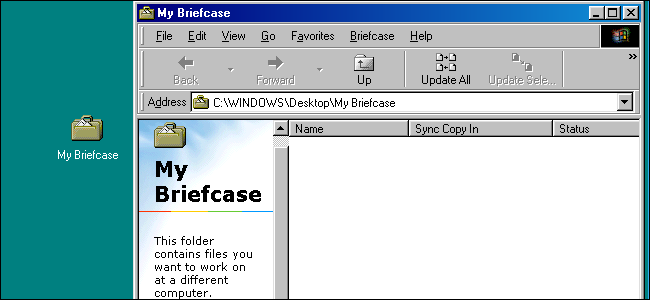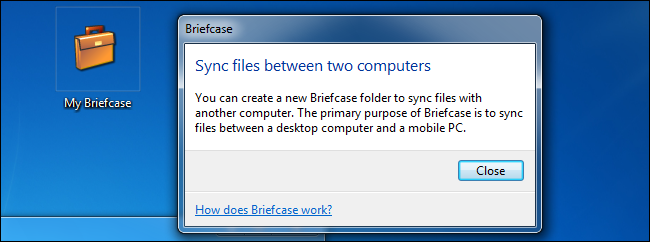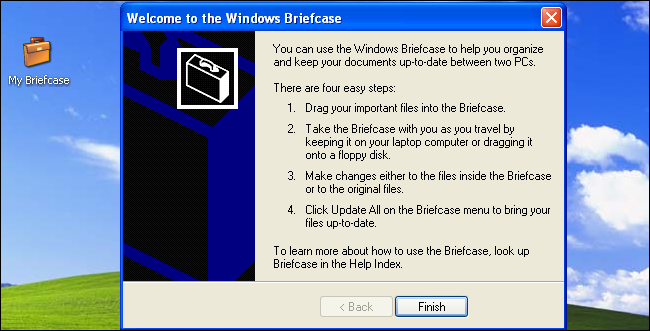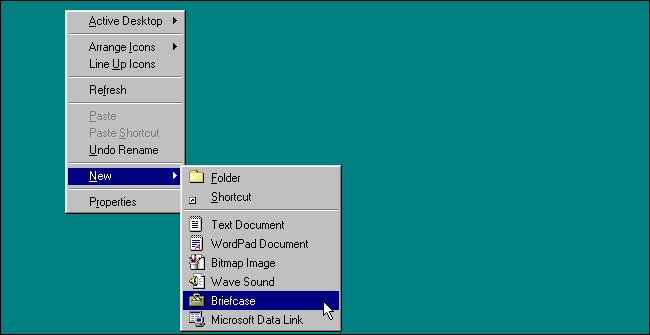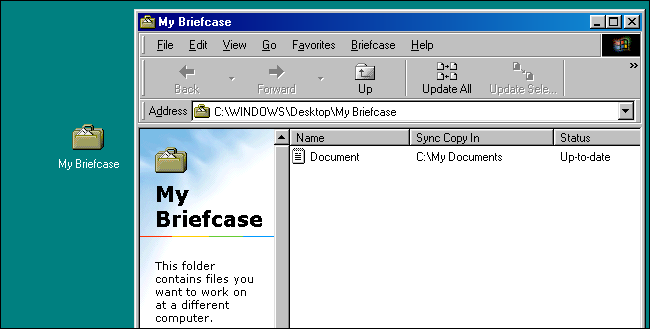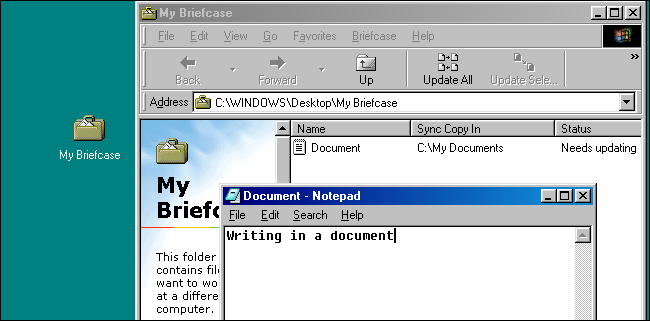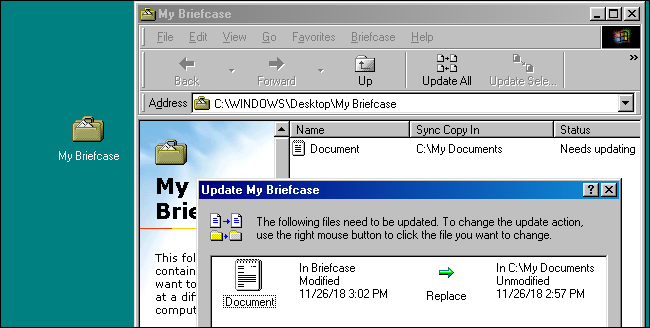Quick Links
The Windows Briefcase was introduced in Windows 95 and was the Dropbox of its day. It's still part of Windows 7, but was deprecated in Windows 8 and is no longer part of Windows 10.
The Briefcase Was All About Syncing Files
If you're old enough, you've probably seen a "My Briefcase" icon on a PC's desktop at some point, even if you've never used the Windows Briefcase.
The Windows Briefcase was designed to make synchronizing files easier in the days before solid Internet connections. For example, you might use it to take essential files from your workplace home on a floppy disk. Or, you might synchronize files from your workplace's local network to your laptop before you disconnect.
It wasn't just about copying files back and forth, which you can do just with copy and paste. The briefcase was all about keeping those files synchronized. If you edited the copy of the files in the briefcase, you could then synchronize them back to the original location. Or, if you had copies of some files in the briefcase and the files were updated at the original location, you could synchronize the Briefcase, updating the briefcase copies to match the originals.
How the Briefcase Worked
Here's how you would've used the Briefcase:
First, you'd store the briefcase on a device that travels with you. For example, if you had a laptop, you could keep the briefcase anywhere on your laptop. If you had a desktop PC, you could place the briefcase on a floppy disk and take that floppy disk home with you.
You could either move the My Briefcase object from the desktop to your floppy disk or right-click in any folder and select New > Briefcase to make a new one.
You'd drag any important files you wanted to take with you into the Briefcase. For example, if you had important documents stored on your workplace's network file server, you could drag those onto the briefcase on your laptop. Or, if you had some files you were using on on your workplace's desktop PC, you could drag them into the briefcase on your floppy disk.
You could also drag entire folders to the briefcase and Windows would synchronize those folders.
Now, you could disconnect your laptop from the network or remove the floppy disk and take it to another PC. The briefcase on the laptop or floppy disk contained copies of whatever files you put into the briefcase. You could view them offline and even make changes. You just opened the briefcase and then opened the files inside.
Windows treated briefcases like practically any other folder. You could open a file directly from the briefcase and save it directly to the briefcase.
Later, you would go back to work and connect your laptop to the workplace's local area network or insert the floppy disk into the desktop computer. To synchronize changes, you'd open the Briefcase and click the "Update All" button on the toolbar. Any changes would be synchronized. For example, if you'd edited the files in the briefcase, your changes would be synchronized back to the file's original locations. If the files on your workplace's network had changed, the copies in your briefcase would be updated.
You could also use the "Update Selected" button to update only a few files. And, whichever way you did it, you'd be prompted to choose which files you wanted to update, so there were no mistakes.
Unlike Dropbox, you couldn't synchronize files on several different PCs with the briefcase. The contents of a briefcase could only be synchronized with one location---that's it. So, while you were away from your workplace, the idea was to only work with the files stored in the briefcase and not drag them out of the briefcase or try to sync them elsewhere.
What Happened to the Briefcase?
The Windows Briefcase was great when it was introduced in Windows 95, but it became less and less important as time went on. Despite this, the Briefcase was still part of Windows XP, Windows Vista, and Windows 7. It was considered "deprecated" in Windows 8. The Windows Briefcase was disabled in the original release of Windows 10, and could only be enabled with a hidden registry setting. It was removed completely with the release of the Creators Update.
Ultimately, the Briefcase became much less important thanks to the Internet. With access to high-speed Internet connectivity practically everywhere, there's usually no need to keep offline copies of files and synchronize them. Even if you need network file shares, you can connect to your workplace's network from anywhere via a VPN.
The Briefcase has also been completely replaced by services like Dropbox, Microsoft OneDrive, and Google Drive. Like the Windows Briefcase, these services synchronize copies of your files between your computers. So, even if you're offline, you can have offline access to your files, and they'll synchronize when you go back online.
Unlike a briefcase, these services let you synchronize files to multiple different computers. All the synchronizing happens automatically, too. There's no need to click an "Update All" button to manually apply changes. The Windows Briefcase is now old-fashioned.

